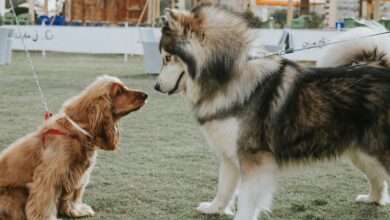Dog Obedience Training: A Complete Guide to a Well-Behaved Pup

Introduction
Dog obedience training is essential for a harmonious relationship between you and your furry companion. A well-trained dog is happier, safer, and more enjoyable to be around. Whether you have a new puppy or an older dog that needs discipline, obedience training helps build trust and establishes clear communication. This guide will provide detailed insights into dog obedience training, covering basic commands, training techniques, common challenges, and advanced skills.
Why Obedience Training is Important
Obedience training offers numerous benefits beyond just good behavior. It enhances the bond between you and your dog, provides mental stimulation, and ensures safety in various situations.
Benefits of Obedience Training:
- Improved Communication: Establishes clear expectations and strengthens your relationship.
- Better Socialization: Helps your dog interact positively with people and other animals.
- Safety: Prevents dangerous situations, such as running into traffic or jumping on strangers.
- Reduced Behavioral Issues: Minimizes excessive barking, aggression, or destructive behaviors.
- Increased Confidence: Helps your dog feel more secure and comfortable in different environments.
Getting Started with Obedience Training
1. Choose the Right Training Method
There are various training methods to consider, and selecting the right one depends on your dog’s personality and your training goals.
- Positive Reinforcement: Rewarding good behavior with treats, praise, or toys.
- Clicker Training: Using a clicking sound to mark desired behaviors, followed by a reward.
- Balanced Training: A mix of positive reinforcement and corrective feedback.
- Relationship-Based Training: Focusing on mutual trust and understanding.
2. Essential Training Tools
- Leash and Collar: Used for guiding your dog and ensuring control.
- Treats: Small, high-value rewards to reinforce positive behavior.
- Clicker: A sound marker for training.
- Training Mats: Helps with designated training areas.
- Interactive Toys: Keeps your dog engaged and motivated.
Basic Obedience Commands
Teaching basic commands lays the foundation for advanced training. Here are essential commands every dog should learn:
1. Sit
- Hold a treat close to your dog’s nose.
- Move your hand upward, causing their head to follow and bottom to lower.
- Once seated, say “Sit” and reward them.
2. Stay
- Ask your dog to sit.
- Open your palm in front of them and say “Stay.”
- Take a step back, and if they remain still, reward them.
3. Come
- Put a leash on your dog.
- Say “Come” while gently pulling the leash.
- Reward when they come towards you.
4. Down (Lie Down)
- Hold a treat close to their nose.
- Move your hand down, guiding them into a lying position.
- Say “Down” and reward.
5. Leave It
- Place a treat in your closed hand.
- Let your dog sniff but not take it.
- Say “Leave it” and reward when they stop trying.
Common Training Challenges and Solutions
Training isn’t always smooth, and challenges may arise. Here’s how to handle them:
1. Excessive Barking
- Identify the cause (boredom, fear, excitement) and address it.
- Teach the “Quiet” command by rewarding silence.
2. Jumping on People
- Ignore jumping and reward calm greetings.
- Teach “Sit” before interaction.
3. Chewing and Destructive Behavior
- Provide chew toys.
- Use deterrent sprays on furniture.
4. Leash Pulling
- Use a no-pull harness.
- Stop walking when they pull and resume when they relax.
Advanced Obedience Training
Once your dog masters basic commands, you can introduce advanced training techniques.
1. Heel Command
- Walk with your dog on a leash.
- Say “Heel” while keeping them beside you.
- Reward when they stay in position.
2. Off-Leash Training
- Train in a secure, enclosed area.
- Reinforce commands like “Come” and “Stay.”
- Gradually increase distractions.
3. Agility Training
- Use obstacles like tunnels and jumps.
- Guide them with commands and hand signals.
4. Service or Therapy Training
- Requires specialized training for emotional support or assistance tasks.
Best Practices for Successful Training
- Consistency is Key: Use the same commands and rewards every time.
- Short Training Sessions: Keep sessions 10-15 minutes long to maintain focus.
- End on a Positive Note: Finish with a successful command to reinforce good behavior.
- Be Patient: Every dog learns at a different pace.
- Socialization: Expose your dog to various environments and people.
Recommended Resources
For further learning, consider these resources:
- Websites: American Kennel Club (AKC), The Humane Society
- Books: The Art of Raising a Puppy by The Monks of New Skete, Zak George’s Dog Training Revolution
- Online Courses: Udemy Dog Training Courses, K9 Training Institute
Conclusion
Dog obedience training is a rewarding process that leads to a well-behaved, happy pet. By using effective training methods, consistency, and patience, you can build a strong bond with your dog and ensure their safety and well-being. Start with basic commands, address behavioral challenges, and advance to higher-level training as your dog progresses. Investing time in obedience training will result in a lifetime of companionship and mutual respect between you and your furry friend.







